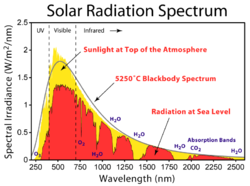Sunlight
2008/9 Schools Wikipedia Selection. Related subjects: Climate and the Weather
Sunlight, in the broad sense, is the total spectrum of the electromagnetic radiation given off by the Sun. On Earth, sunlight is filtered through the atmosphere, and the solar radiation is obvious as daylight when the Sun is above the horizon. This is usually during the hours known as day. Near the poles in summer, sunlight also occurs during the hours known as night and in the winter at the poles sunlight may not occur at any time. When the direct radiation is not blocked by clouds, it is experienced as sunshine, a combination of bright light and heat. Radiant heat directly produced by the radiation of the sun is different from the increase in atmospheric temperature due to the radiative heating of the atmosphere by the sun's radiation. Sunlight may be recorded using a sunshine recorder. The World Meteorological Organization defines sunshine as direct irradiance from the Sun measured on the ground of at least 120 W· m−2.
Direct sunlight gives about 93 lumens of illumination per watt of electromagnetic power, including infrared, visible, and ultra-violet.
Sunlight is a key factor in the process of photosynthesis.
Calculation
To calculate the amount of sunlight reaching the ground both the elliptical orbit of the earth and the earth's atmosphere have to be taken into account. The extraterrestrial solar illuminance (Eext), corrected for the elliptical orbit by using the day number of the year, known as the Julian date (Jd), is: Eext=Esc(1 + 0.034 * cos(2pi(Jd − 2) / 365))
The solar illuminance constant (Esc), is equal to 128 Klux. The direct normal illuminance, (Edn), corrected for the attenuating effects of the atmosphere is given by: Edn=Eext*e-cm
Where c is the atmospheric extinction coefficient and m is the relative optical air mass.
Composition of sunlight
The spectrum of electromagnetic radiation striking the Earth's atmosphere is 100 to 106 nanometer (nm). This can be divided into five regions in increasing order of wavelengths:
- Ultraviolet C or (UVC) range, which spans a range of 100 to 280 nm. The term ultraviolet implies that the radiation is more intense than the visible range of light (and, hence also invisible to the human eye). Owing to absorption by the atmosphere very little reaches the Earth's surface ( Lithosphere). This spectrum of radiation has germicidal properties, and is used in germicidal lamps.
- Ultraviolet B or (UVB) range spans 280 to 315 nm. It is also greatly absorbed by the atmosphere, and along with UVC is responsible for the photochemical reaction leading to the production of the Ozone layer.
- Ultraviolet A or (UVA) spans 315 to 400 nm. It has been traditionally held as less damaging to the DNA, and hence used in tanning and PUVA therapy for psoriasis.
- Visible range or light spans 400 to 700 nm. As the name suggests, it is this range that is visible to the naked eye.
- Infrared range that spans 700 nm to 106 nm [1 millimeter (mm)]. It is largely responsible for the warmth or heat that the sunlight carries. It is also divided into three types on the basis of wavelength:
- Infrared-A: 700 nm to 1400 nm
- Infrared-B: 1400 nm to 3000 nm
- Infrared-C: 3000 nm to 1 mm.
Life on Earth
The existence of nearly all life on Earth is fueled by light from the sun. Most autotrophs, such as plants, use the energy of sunlight to turn air into simple sugars—a process known as photosynthesis. These sugars are then used as building blocks and in other synthetic pathways which allow the organism to grow.
Heterotrophs, such as animals, use light from the sun indirectly by consuming the products of autotrophs, either directly or by consuming other heterotrophs. The sugars and other molecular components produced by the autotrophs are then broken down, releasing stored solar energy, and giving the heterotroph the energy required for survival. This process is known as respiration.
In prehistory, humans began to further extend this process by putting plant and animal materials to other uses. They used animal skins for warmth, for example, or wooden weapons to hunt. These skills allowed humans to harvest more of the sunlight than was possible through glycolysis alone, and human population began to grow.
During the Neolithic Revolution, the domestication of plants and animals further increased human access to solar energy. Fields devoted to crops were enriched by inedible plant matter, providing sugars and nutrients for future harvests. Animals which had previously only provided humans with meat and tools once they were killed were now used for labour throughout their lives, fueled by grasses inedible to humans.
The more recent discoveries of coal, petroleum and natural gas are modern extensions of this trend. These fossil fuels are the remnants of ancient plant and animal matter, formed using energy from sunlight and then trapped within the earth for millions of years. Because the stored energy in these fossil fuels has accumulated over many millions of years, they have allowed modern humans to massively increase the production and consumption of primary energy. As the amount of fossil fuel is large but finite, this cannot continue indefinitely, and various theories exist as to what will follow this stage of human civilization (e.g. alternative fuels, Malthusian catastrophe, new urbanism, peak oil).
Cultural aspects
Many people find direct sunlight to be too bright for comfort, especially when reading from white paper upon which the sun is directly shining. Indeed, looking directly at the sun can cause permanent vision damage. To compensate for the brightness of sunlight, many people wear sunglasses. Cars, many helmets and caps are equipped with visors to block the sun from direct vision when the sun is at a low angle.
In colder countries many people prefer sunnier days and often avoid the shade. In hotter countries the converse is true; during the midday hours many people prefer to stay inside to remain cool. If they do go outside, they seek shade which may be provided by trees, parasols, and so on.
Sunshine is often blocked from entering buildings through the use of window blinds, awnings, shutters or curtains.
Sunbathing
Sunbathing is popular for the cosmetic and potential health benefits of a sun tan, although there are also risks of cellular damage to the skin. Sunbathing is a popular leisure activity in which a person sits or lies in direct sunshine. People often sunbathe in comfortable places where there is ample sunlight. Some common places for sunbathing include the beach, open air swimming pools, the park, the garden, and sidewalk cafés. Sunbathers typically wear limited amounts of clothing or some simply go nude.
An alternative some use to sunbathing is to use a sunbed that generates ultraviolet light and can be used indoors regardless of outdoor weather conditions and amount of sun light.
For many people with pale or brownish skin, an additional or primary purpose for sunbathing is to darken one's skin colour (get a sun tan) as this is considered in some cultures to be beautiful, associated with outdoor activity, vacations or holidays, and health. Indeed, the body produces vitamin D from sunlight (specifically from the UVB band of ultraviolet light), and excessive seclusion from the sun can lead to deficiency. An additional reason that some people prefer nude sunbathing is that an "all-over" or "even" tan can be obtained.
Skin tanning is achieved by an increase in the dark pigment inside skin cells called melanocytes and it is actually an automatic response mechanism of the body to sufficient exposure to ultraviolet radiation from the sun or from artificial sunlamps. Thus, the tan gradually disappears with time, when one is no longer exposed to these sources.
Effects on health
While the production of vitamin D is beneficial to health, excessive sunlight exposure has been linked to all types of skin cancer caused by the ultraviolet part of radiation from sunlight or sunlamps. Sunburn can have mild to severe inflammation effects on skin; this can be avoided by using a proper sunscreen cream or lotion or by gradually building up melanocytes with increasing exposure. Another detrimental effect of UV exposure is accelerated skin aging (also called skin photodamage), which produces a difficult to treat cosmetic effect. (Although some people are concerned that ozone depletion is increasing the incidence of such health hazards.)
A lack of sunlight, on the other hand, is considered one of the primary causes of seasonal affective disorder (SAD), a serious form of the "winter blues". SAD occurrence is more prevalent in locations further from the tropics, and most of the treatments (other than prescription drugs) involve replicating sunlight via sunlamps tuned to specific wavelengths of light or full-spectrum bulbs.


